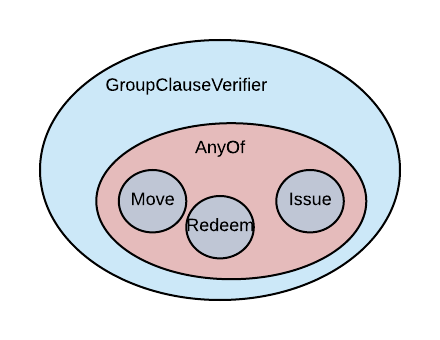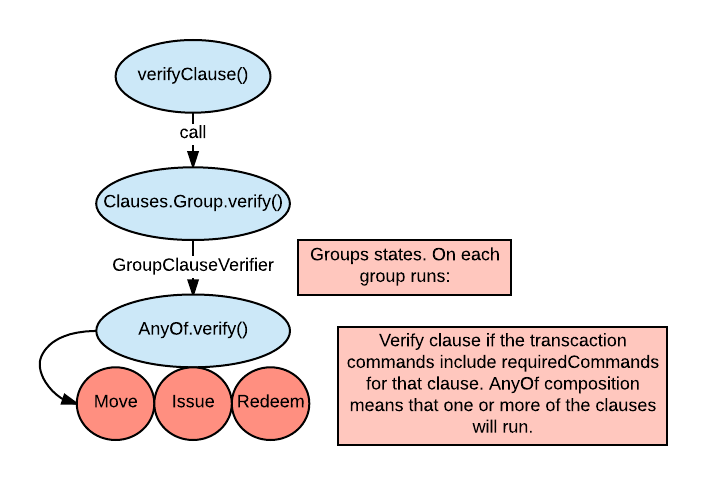Writing a contract using clauses¶
In this tutorial, we will restructure the commercial paper contract to use clauses. You should have already completed “Writing a contract”.
As before, this example is focused on a basic implementation of commercial paper (CP), which is essentially a simpler version of a corporate
bond. A company issues commercial paper with a particular face value, say $100, but sells it for less, say $90. The paper can be redeemed
for cash at a given future date. In our example, the commercial paper has a 10% interest rate, with a single repayment.
The full Kotlin code can be found in CommercialPaper.kt.
What are clauses and why use them?¶
Clauses are essentially micro-contracts which contain independent verification logic, and can be logically composed to form a complete contract. Clauses are designed to enable re-use of common verification parts. For example, issuing state objects is generally the same for all fungible contracts, so a common issuance clause can be used for each contract’s issue clause. This cuts down on scope for error, and improves consistency of behaviour. By splitting verification logic into smaller chunks, these can also be readily tested in isolation.
How do clauses work?¶
There are different types of clauses. The most basic are those that define the verification logic for a single command
(e.g. Move, Issue and Redeem, in the case of commercial paper), or even run without any commands at all (e.g. Timestamp).
These basic clauses can then be combined using a CompositeClause. The goal of composite clauses is to determine
which individual clauses need to be matched and verified for a given transaction
to be considered valid. We refer to a clause as being “matched” when the transaction has the required commands present for the clause
in question to trigger. Meanwhile, we talk about a clause “verifying” when its verify() function returns True.
As an example, let’s say we want a transaction to be valid only when every single one of its clauses matches and verifies. We implement this
by wrapping the individual clauses into an AllOf composite clause, which ensures that a transaction is
only considered valid if all of its clauses are both matched and verify.
There are two other basic composite clauses that you should be aware of:
AnyOf, whereby 1 or more clauses may match, and every matched clause must verifyFirstOf, whereby at least one clause must match, and the first such clause must verify
In turn, composite clauses are themselves Clause s, and can, for example, be wrapped in the special GroupClauseVerifier grouping clause.
For CommercialPaper, this would look as follows:

For this tutorial, we will be using GroupClauseVerifier and AnyOf. Since it’s important to understand how these work,
charts showing their execution and other details can be found in Clauses.
Commercial paper class¶
We start by defining the CommercialPaper class. As in the previous tutorial, we need some elementary parts: a Commands interface,
generateMove, generateIssue, generateRedeem. So far, so good - these stay the same. The new part is verification and the
Clauses interface (which we will see later in code). Let’s start from the basic structure:
class CommercialPaper : Contract {
override val legalContractReference: SecureHash = SecureHash.sha256("https://en.wikipedia.org/wiki/Commercial_paper")
override fun verify(tx: LedgerTransaction) = verifyClause(tx, Clauses.Group(), tx.commands.select<Commands>())
interface Commands : CommandData {
data class Move(override val contractHash: SecureHash? = null) : FungibleAsset.Commands.Move, Commands
class Redeem : TypeOnlyCommandData(), Commands
data class Issue(override val nonce: Long = random63BitValue()) : IssueCommand, Commands
}
public class CommercialPaper implements Contract {
@Override
public SecureHash getLegalContractReference() {
return SecureHash.Companion.sha256("https://en.wikipedia.org/wiki/Commercial_paper");
}
@Override
public void verify(@NotNull LedgerTransaction tx) throws IllegalArgumentException {
ClauseVerifier.verifyClause(tx, new Clauses.Group(), extractCommands(tx));
}
public interface Commands extends CommandData {
class Move implements Commands {
@Override
public boolean equals(Object obj) { return obj instanceof Move; }
}
class Redeem implements Commands {
@Override
public boolean equals(Object obj) { return obj instanceof Redeem; }
}
class Issue implements Commands {
@Override
public boolean equals(Object obj) { return obj instanceof Issue; }
}
}
As you can see, we used verifyClause function with Clauses.Group() in place of our previous verification logic.
It’s an entry point to running clause logic. verifyClause takes the transaction, a clause (usually a composite one)
to verify, and all of the commands the clause is expected to handle. This list of commands is important because
verifyClause checks that none of the commands are left unprocessed at the end, raising an error if they are.
Simple Clauses¶
Let’s move to constructing contract logic in terms of clauses. The commercial paper contract has three commands and
three corresponding behaviours: Issue, Move and Redeem. Each of them has a specific set of requirements that must be satisfied -
perfect material for defining clauses. For brevity, we will only show the Move clause. The rest is constructed in similar manner,
and is included in the CommercialPaper.kt code.
interface Clauses {
class Move: Clause<State, Commands, Issued<Terms>>() {
override val requiredCommands: Set<Class<out CommandData>>
get() = setOf(Commands.Move::class.java)
override fun verify(tx: LedgerTransaction,
inputs: List<State>,
outputs: List<State>,
commands: List<AuthenticatedObject<Commands>>,
groupingKey: Issued<Terms>?): Set<Commands> {
val command = commands.requireSingleCommand<Commands.Move>()
val input = inputs.single()
requireThat {
"the transaction is signed by the owner of the CP" using (input.owner.owningKey in command.signers)
"the state is propagated" using (outputs.size == 1)
// Don't need to check anything else, as if outputs.size == 1 then the output is equal to
// the input ignoring the owner field due to the grouping.
}
return setOf(command.value)
}
}
...
public interface Clauses {
class Move extends Clause<State, Commands, State> {
@NotNull
@Override
public Set<Class<? extends CommandData>> getRequiredCommands() {
return Collections.singleton(Commands.Move.class);
}
@NotNull
@Override
public Set<Commands> verify(@NotNull LedgerTransaction tx,
@NotNull List<? extends State> inputs,
@NotNull List<? extends State> outputs,
@NotNull List<? extends AuthenticatedObject<? extends Commands>> commands,
@NotNull State groupingKey) {
AuthenticatedObject<Commands.Move> cmd = requireSingleCommand(tx.getCommands(), Commands.Move.class);
// There should be only a single input due to aggregation above
State input = single(inputs);
if (!cmd.getSigners().contains(input.getOwner().getOwningKey()))
throw new IllegalStateException("Failed requirement: the transaction is signed by the owner of the CP");
// Check the output CP state is the same as the input state, ignoring the owner field.
if (outputs.size() != 1) {
throw new IllegalStateException("the state is propagated");
}
// Don't need to check anything else, as if outputs.size == 1 then the output is equal to
// the input ignoring the owner field due to the grouping.
return Collections.singleton(cmd.getValue());
}
}
...
We took part of the code for Command.Move verification from the previous tutorial and put it into the verify function
of Move class. Notice that this class must extend the Clause abstract class, which defines
the verify function and the requiredCommands property used to determine the conditions under which a clause
is triggered. In the above example, this means that the clause will run its verification logic when Commands.Move is present in a transaction.
Note
Notice that commands refer to all input and output states in a transaction. For a clause to be executed, the transaction has
to include all commands from the requiredCommands set.
A few important changes:
- The
verifyfunction returns the set of commands which it has processed. Normally this set is identical to therequiredCommandsused to trigger the clause. However, in some cases, the clause may process further optional commands which it needs to report that it has handled. - Verification takes new parameters. Usually inputs and outputs are some subset of the original transaction entries
passed to the clause by outer composite or grouping clause.
groupingKeyis a key used to group original states.
As a simple example, imagine the following input states:
- 1000 GBP issued by Bank of England
- 500 GBP issued by Bank of England
- 1000 GBP issued by Bank of Scotland
We will group states by Issuer, meaning that we have inputs 1 and 2 in one group, and input 3 in another group. The grouping keys are ‘GBP issued by Bank of England’ and ‘GBP issued by Bank of Scotland’.
How are the states grouped and passed in this form to the Move clause? Answering that question leads us to the concept of
GroupClauseVerifier.
Group clause¶
We may have a transaction with similar but unrelated state evolutions which need to be validated independently. It
makes sense to check the Move command on groups of related inputs and outputs (see example above). Thus, we need to collect
relevant states together.
For this, we extend the standard GroupClauseVerifier and specify how to group input/output states, as well as the top-level
clause to run on each group. In our example, the top level is a composite clause - AnyCompostion - that delegates verification to
its subclauses (wrapped move, issue, redeem). “Any” in this case means that it will take 0 or more clauses that match the transaction commands.
class Group : GroupClauseVerifier<State, Commands, Issued<Terms>>(
AnyOf(
Redeem(),
Move(),
Issue())) {
override fun groupStates(tx: LedgerTransaction): List<LedgerTransaction.InOutGroup<State, Issued<Terms>>>
= tx.groupStates<State, Issued<Terms>> { it.token }
}
class Group extends GroupClauseVerifier<State, Commands, State> {
public Group() {
super(new AnyOf<>(
new Clauses.Redeem(),
new Clauses.Move(),
new Clauses.Issue()
));
}
@NotNull
@Override
public List<InOutGroup<State, State>> groupStates(@NotNull LedgerTransaction tx) {
return tx.groupStates(State.class, State::withoutOwner);
}
}
For the CommercialPaper contract, Group is the main clause for the contract, and is passed directly into
verifyClause (see the example code at the top of this tutorial). We also used groupStates function here - it
may be worth reminding yourself how it works here: Using state groups.
Summary¶
In summary, the top-level contract CommercialPaper specifies a single grouping clause of type
CommercialPaper.Clauses.Group, which in turn specifies GroupClause implementations for each type of command
(Redeem, Move and Issue). This reflects the verification flow: in order to verify CommercialPaper,
we first group states, then we check which commands are specified, and finally we run command-specific verification logic accordingly.

Debugging¶
Debugging clauses which have been composed together can be complicated due to the difficulty in knowing which clauses
have been matched, whether specific clauses failed to match or passed verification, etc. There is “trace” level
logging code in the clause verifier which evaluates which clauses will be matched and logs them, before actually
performing the validation. To enable this, ensure trace level logging is enabled on the Clause interface.